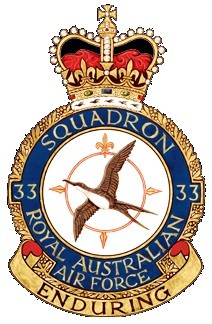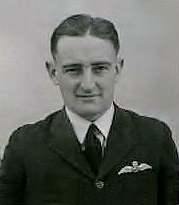Related Research Articles

The Royal Australian Air Force (RAAF) is the principal air and space force of Australia, a part of the Australian Defence Force (ADF) along with the Royal Australian Navy and the Australian Army. Constitutionally the Governor-General of Australia is the de jure Commander-in-Chief of the Australian Defence Force. The Royal Australian Air Force is commanded by the Chief of Air Force (CAF), who is subordinate to the Chief of the Defence Force (CDF). The CAF is also directly responsible to the Minister for Defence, with the Department of Defence administering the ADF and the Air Force.

The Boeing 737 AEW&C is a twin-engine airborne early warning and control aircraft based on the Boeing 737 Next Generation design. It is lighter than the 707-based Boeing E-3 Sentry, and has a fixed, active electronically scanned array radar antenna instead of a rotating one. It was designed for the Royal Australian Air Force (RAAF) under "Project Wedgetail" and designated E-7A Wedgetail.

No. 10 Squadron is a Royal Australian Air Force (RAAF) signals intelligence squadron based at RAAF Base Edinburgh, South Australia. It is part of No. 42 Wing RAAF. The squadron was formed in 1939 as a maritime patrol unit. It saw active service during the Second World War, conducting anti-submarine operations and patrols from bases in the United Kingdom until it disbanded in late 1945. It was re-formed in Australia in 1949 and since then has contributed to Australia's East Timor intervention, and has been deployed to the Middle East as part of the War on Terrorism and the 2003 Gulf War. Most recently it now has a signals intelligence mission.

No. 33 Squadron is a Royal Australian Air Force (RAAF) strategic transport and air-to-air refuelling squadron. It operates Airbus KC-30A Multi Role Tanker Transports from RAAF Base Amberley, Queensland. The squadron was formed in February 1942 for service during World War II, operating Short Empire flying boats and a variety of smaller aircraft. By 1944 it had completely re-equipped with Douglas C-47 Dakota transports, which it flew in New Guinea prior to disbanding in May 1946.
Chief of Air Force (CAF) is the most senior appointment in the Royal Australian Air Force (RAAF), responsible to the Chief of the Defence Force (CDF) and the Secretary of the Department of Defence. The rank associated with the position is air marshal (three-star). The role encompasses "the delivery of aerospace capability, enhancing the Air Force's reputation and positioning the Air Force for the future". It does not include direction of air operations, which is the purview of the Air Commander Australia, a two-star position responsible directly to CDF in such circumstances but nominally reporting to CAF.
Air Command is the operational arm of the Royal Australian Air Force (RAAF). It is headed by the Air Commander Australia, whose role is to manage and command the RAAF's Force Element Groups (FEGs), which contain the operational capability of the Air Force. Headquarters Air Command is located at RAAF Base Glenbrook.

Air Force Training Group is the Royal Australian Air Force (RAAF) group responsible for training personnel. It is headquartered at RAAF Williams, Victoria. The group was established as Training Command in 1953. It formed part of Support Command between from 1959 to 1990, when it was re-established as Training Command. In July 2006, Training Command was re-formed as Air Force Training Group under Air Command. Air Force Training Group consists of a headquarters and two Academies: Air Academy and Ground Academy.

The Royal Australian Air Force's Air Combat Group (ACG) is the group which administers the RAAF's fighter and bomber aircraft. ACG was formed on 7 February 2002 by merging the RAAF's Tactical Fighter Group and Strike Reconnaissance Group in an attempt to improve the speed with which the RAAF can deploy its combat aircraft.
The Force Element Groups (FEGs) of the Australian Defence Force are the operational capabilities.
Capabilities are formed into Force Elements (FE), which in turn are aggregated into Force Element Groups (FEG). Each capability is assigned a level of operational readiness. The level of capability maintained by an FE or FEG should be consistent with its assigned readiness notice and depends on the availability of trained personnel, the availability of major platforms, combat systems and supplies, and the standard of collective training.

Air Chief Marshal Sir Frederick Rudolph William Scherger, was a senior commander in the Royal Australian Air Force (RAAF). He served as Chief of the Air Staff, the RAAF's highest-ranking position, from 1957 until 1961, and as Chairman of the Chiefs of Staff Committee, forerunner of the role of Australia's Chief of the Defence Force, from 1961 until 1966. He was the first RAAF officer to hold the rank of air chief marshal.

Air Chief Marshal Sir Neville Patrick McNamara, was a senior commander of the Royal Australian Air Force (RAAF). He served as Chief of the Air Staff (CAS), the RAAF's highest-ranking position, from 1979 until 1982, and as Chief of the Defence Force Staff (CDFS), Australia's top military role at the time, from 1982 until 1984. He was the second RAAF officer to hold the rank of air chief marshal.

Air Vice Marshal William Dowling Bostock, was a senior commander in the Royal Australian Air Force (RAAF). During World War II he led RAAF Command, the Air Force's main operational formation, with responsibility for the defence of Australia and air offensives against Japanese targets in the South West Pacific Area. His achievements in the role earned him the Distinguished Service Order and the American Medal of Freedom. General Douglas MacArthur described him as "one of the world's most successful airmen".

Air Chief Marshal Mark Donald Binskin, is a former senior officer in the Royal Australian Air Force. He served as Chief of Air Force (2008–11), Vice Chief of the Defence Force (2011–14), and Chief of the Defence Force from June 2014 until his retirement in July 2018. In February 2020 he was appointed as a Commissioner and Chairman of the Royal Commission into National Natural Disaster Arrangements. He is the current chair of the Civil Aviation Safety Authority of Australia.

Air Marshal Sir Alister Murray Murdoch, was a senior commander in the Royal Australian Air Force (RAAF). He served as Chief of the Air Staff (CAS) from 1965 to 1969. Joining the Air Force in 1930, Murdoch trained as a seaplane pilot and participated in an Antarctic rescue mission for lost explorers in 1935. During World War II, he commanded No. 221 Squadron RAF in Europe and the Middle East, and later occupied senior positions on the staff of RAAF formations in the South West Pacific. His post-war appointments included Commandant of RAAF College from 1952 to 1953, Air Officer Commanding (AOC) Training Command from 1953 to 1955, Deputy Chief of the Air Staff from 1958 to 1959, and AOC Operational Command from 1962 to 1965.

Air Vice Marshal Allan Leslie Walters, CB, CBE, AFC was a senior commander in the Royal Australian Air Force (RAAF). Born in Victoria and raised in Western Australia, he graduated from the Royal Military College, Duntroon, before transferring to the RAAF in 1928. He was one of the service's leading flying instructors and aerobatic pilots between the wars, and was appointed to his first squadron command in 1937. Over the course of World War II, Walters led No. 1 Squadron in Singapore, No. 1 (Fighter) Wing in Darwin, Northern Territory, No. 72 Wing in Dutch New Guinea, and Northern Command in Papua New Guinea. He was decorated with the Air Force Cross in 1941 for his work with No. 1 Squadron, and mentioned in despatches in 1944 for his service with No. 72 Wing.

Air Marshal Melvin Ernest Glanville Hupfeld, is a retired senior officer of the Royal Australian Air Force. He served as Air Commander Australia from 2012 to 2014 and was the acting and final Chief Capability Development Group (2015–16), before being appointed as Head Force Design in the Vice Chief of the Defence Force Group (2016–18). He was promoted air marshal and made Chief of Joint Operations in May 2018, and succeeded Air Marshal Leo Davies as Chief of Air Force in July 2019.

Air Vice Marshal Frank Headlam, was a senior commander in the Royal Australian Air Force (RAAF). Born and educated in Tasmania, he joined the RAAF as an air cadet in January 1934. He specialised in flying instruction and navigation before the outbreak of World War II. In April 1941, he became commanding officer of No. 2 Squadron, which operated Lockheed Hudsons. The squadron was deployed to Dutch Timor in December, and saw action against Japanese forces in the South West Pacific. After returning to Australia in February 1942, Headlam held staff appointments and training commands, finishing the war a group captain.

The Air Board, also known as the Administrative Air Board, or the Air Board of Administration, was the controlling body of the Royal Australian Air Force (RAAF) from 1921 to 1976. It was composed of senior RAAF officers as well as some civilian members, and chaired by the Chief of the Air Staff (CAS). The CAS was the operational head of the Air Force, and the other board members were responsible for specific areas of the service such as personnel, supply, engineering, and finance. Originally based in Melbourne, the board relocated to Canberra in 1961.
Air Vice Marshal Steven Peter "Zed" Roberton, is a retired senior commander of the Royal Australian Air Force (RAAF). He joined the RAAF in 1989 and trained as a fighter pilot. He has deployed to Iraq, commanded No. 75 Squadron RAAF (2003–06) and No. 82 Wing RAAF (2010–11), and led Air Task Group 630 on operations against the Islamic State of Iraq and the Levant (2014–15). He served as commander Air Combat Group RAAF from 2015 to 2017, Air Commander Australia from 2017 to 2019, and Head Force Design within the Vice Chief of Defence Force Group from June 2019 to February 2022.

Air Marshal Robert Timothy Chipman, is a senior officer in the Royal Australian Air Force (RAAF) who serves as Chief of Air Force since July 2022. He joined the RAAF as an aeronautical engineer in 1989 and gained his pilot's wings in 1994. He has commanded No. 75 Squadron RAAF (2006–09), the Air and Space Operations Centre (2010–12), No. 81 Wing RAAF (2013–14) and Air Task Unit 630.1 (2014), and deployed to the Middle East on Operations Slipper and Okra. He served as the Australian Military Representative to NATO and the European Union from 2019 to 2021 and Head Military Strategic Commitments from 2021 to 2022. He succeeded Air Marshal Mel Hupfeld as Chief of Air Force on 1 July 2022.
References
- ↑ "Defence Space Command". Royal Australian Air Force. Retrieved 23 March 2022.
- ↑ Hurst, Daniel (22 March 2022). "China could 'take out' Australian satellites says new head of Defence's space command". The Guardian Australia. Retrieved 22 March 2022.
- ↑ "Defence Space Commander". Royal Australian Air Force. Retrieved 19 April 2022.